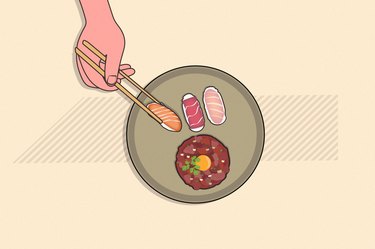
Scan a protein bar's ingredients list and you'll likely spot soy protein isolate somewhere in the long paragraph of (often unfamiliar) items.
The term "soy protein isolate" sounds straightforward enough, but when you stop to think about it, you might realize you're not actually sure how the increasingly popular ingredient is produced or if it even differs from the protein found in other soy-based products like tofu or tempeh. Luckily, we've got answers.
Video of the Day
Video of the Day
Below, registered dietitians answer all your questions about soy protein isolate, including where it's found, how it stacks up nutritionally and whether it's OK to eat the ingredient regularly.
What Is Soy Protein Isolate?
Soy protein isolate, often referred to as SPI, is a processed form of soy that's made from soybeans that have been soaked in alcohol or another solvent to remove their fiber and sugar; they're then dehydrated to form a powder, says Amanda Wahlstedt, RD, a registered dietitian and founder of the private practice Roots to Leaves.
This process generates a product that's almost pure protein: SPI is typically more than 90 percent protein by weight, per an October 2004 report in The Journal of Nutrition.
It's worth noting that SPI is heavily processed in comparison to alternative sources of soy. "Tofu is not chemically processed … and tempeh is another whole-food source of soy that is fermented, which can make it easier to digest," says Sarah Becker, RD, a registered dietitian at Indigo Wellness Group. "Fermented foods add a whole other layer of benefits, especially for our gut health."
Soy Protein Isolate vs. Soy Protein Concentrate
Soy protein isolate isn’t the same as soy protein concentrate. While SPI is around 90 percent protein, soy protein concentrate is lower in protein, at about 65 to 70 percent protein by weight, per the October 2004 Journal of Nutrition report.
How Is SPI Made?
SPI production is anything but straightforward. The process typically requires the use of chemicals like ethanol (alcohol) and hexane (a compound found in gasoline), as well as sodium hydroxide (NaOH) and hydrochloric acid (HCl), per February 2015 research in the Journal of Food Science and Technology.
The first step of SPI production includes soaking the soybeans in hexane, which removes the natural oils from the legumes, according to the Environmental Protection Agency. From there, the "defatted" and flaked soybeans are exposed to either ethanol or other acidic solution that strips away the product's natural flavors and carbohydrate components, per March 1995 research in The Journal of Nutrition.
Later, the (now unrecognizable) soybeans undergo further processing using methods like alkali extraction, centrifugation and dehydration to form the high-protein, fiber-free powder that is SPI.
By comparison, tofu is produced by soaking crushed soybeans in water. The soy milk created during this process is then combined with calcium or magnesium salts that act as coagulants to form curds.
Soy Protein Isolate in Foods
SPI shows up in a wide variety of processed foods, including:
- Protein bars
- Protein powders
- Pre-made protein shakes
- Faux meat products
- Soy-based infant formulas
- High-protein granolas
Soy Protein Isolate Nutrition Facts
"While a 1-ounce serving of SPI provides upwards of 20 grams of protein, it's otherwise devoid of other nutrients," Wahlstedt says. "In comparison, a 3-ounce serving of tofu or tempeh can have more than 15 grams of protein, as well as fiber, healthy fats and vitamins and minerals such as manganese and calcium."
Despite being packed with protein, SPI is low in calories. A 1/4-cup serving of protein powder made from SPI offers 25 grams of protein for just 95 calories, according to USDA.
Benefits of Soy Protein Isolate
Despite the great debate about soy, research suggests the plant can be a healthful addition to most peoples' diets.
It's a Source of Complete Protein
Soy is one of the only plants that provide all nine of the essential amino acids, the building blocks of proteins that we must get from foods. This makes it an attractive option for people looking for a vegan-friendly form of complete protein.
It's Rich in Phytoestrogens
"The controversy around soy has been due to its phytoestrogens, plant compounds that have estrogen-like properties," Wahlstedt explains. "However, the estrogen present in soy is generally a weaker form than our body's circulating estrogen, meaning that it tends to have an anti-estrogenic effect."
In other words, the estrogen-like compounds in soy can bind with estrogen receptors in the body and block the adverse effects of excess true estrogens in the body. "In this way, soy [may actually] help reduce issues related to estrogen dominance and some studies have even suggested that it can reduce the risk of some cancers."
It's Linked With Heart Health
Eating soy regularly has also been associated with a lower risk of heart disease, per the Harvard T.H. Chan School of Public Health.
But here's the catch: So far, research has largely studied the health benefits of foods like soybeans, tofu and tempeh — not SPI. Whether or not these advantages also follow from SPI intake remains to be seen.
Who Should Avoid Soy?
“There are situations where soy may not be advised, such as if you have certain thyroid issues, a history of hormone-sensitive cancer or a soy allergy,” Wahlstedt says. If any of these apply to you, talk to your doctor or registered dietitian to discuss whether — or how much — soy is right for you.
Risks of Soy Protein Isolate
While it's not necessarily risky to eat SPI, it also doesn't need to be an everyday staple in your diet.
It's Often Found in Ultra-Processed Foods
For one, SPI "is commonly added to ultra-processed foods, such as protein powders and bars that often contain sweeteners and other additives," Wahlstedt says.
"Research consistently links [regular consumption of] ultra-processed foods to a greater risk of health conditions like heart disease and diabetes."
And just like any other dietary supplement, SPI-based protein powders may be subject to mislabeling or contamination due to the lack of FDA oversight of such products.
"In 2018, the Clean Label Project tested 133 protein powders and found that plant-based protein powders were the biggest culprits of heavy metals, specifically arsenic and cadmium," Becker says.
While the August 2020 study in Toxicology Reports found that the protein powders' heavy metal loads did not reach levels capable of causing health risks, Becker believes it's still important to shop smart when choosing products containing SPI.
Tip
“If you’re using [SPI powder] in a smoothie, I’d be mindful of sourcing and see if you can buy a third-party tested brand, which helps ensure quality and that the ingredients in the product truly match what’s listed on the nutrition label," Becker says.
What About GMOs?
While it's true that soy is one of the most commonly genetically modified crops in the U.S., the jury is still out on how (or even whether) GMOs compromise human health.
The FDA "ensures that GMOs are safe for human, plant and animal health," and research thus far has not demonstrated that GMOs cause adverse health outcomes, per Harvard University. Critics point to the fact that modern technologies used for genetic modification are fairly new, so we can't yet confirm how they may affect our health long term. Question marks around the safety of glyphosate, an herbicide widely used on genetically modified soybean plants, also remain.
"There is no conclusive scientific evidence to support the [negative] effects of GMOs, but that doesn't mean there aren't any," Becker says. "Where there's [potential for] risk, avoid it and minimize exposure when possible."
Becker encourages her clients to opt for non-GMO, organic soy products if it's available to them: "The price difference between organic and non-organic soy products is generally minimal, at around 99 cents or less," Becker adds.
The Bottom Line
"All in all, SPI may not be the biggest red flag when it comes to health," Wahlstedt says. "However, it is still an ultra-processed product." What's more, SPI is exactly what it sounds like: an isolated nutrient. A more balanced approach focuses on the totality of nutrients offered up by whole foods.
"If you're trying to boost your plant-based protein intake, organic tofu, tempeh and edamame are all wonderful sources that will provide you with a healthy dose of protein in addition to other nutrients," Wahlstedt says.
While SPI surely isn't the enemy, it's also not a critical component of a nourishing diet. "Sometimes products containing SPI can't be avoided, but I'm a fan of opting for real, whole-food sources of plant protein," Becker says. "Reduce consumption [of SPI] when possible, but don't drive yourself crazy if it's the only option available to you once in a blue moon."
And remember that variety is a hallmark of a nutritious diet. In addition to tofu and tempeh, add legumes, nuts and seeds to your plate for more nutrient-dense sources of plant protein.
- Harvard T.H. Chan School of Public Health: “Straight Talk About Soy”
- Toxicology Reports: "A Human Health Risk Assessment of Heavy Metal Ingestion Among Consumers of Protein Powder Supplements"
- Harvard University: “Will GMOs Hurt My Body? The Public’s Concerns and How Scientists Have Addressed Them”
- International Journal of Environmental Research and Public Health: "Non-Hodgkin Lymphoma and Occupational Exposure to Agricultural Pesticide Chemical Groups and Active Ingredients: A Systematic Review and Meta-Analysis"
- My Food Data: "Soy Protein Powder (Isolate)"



